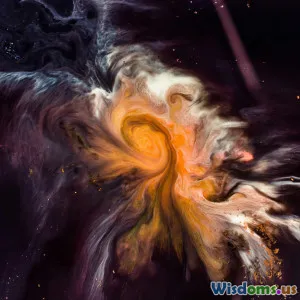
Understanding Black Holes: A Beginner's Guide
6 min read Explore the mysteries of black holes in this beginner's guide that breaks down their nature, discovery, and significance in space. (0 Reviews)
Understanding Black Holes: A Beginner's Guide
Introduction
Black holes have captivated human imagination for decades, conjuring images of cosmic monsters that swallow everything in their path. But what truly are black holes? How do they form, and why do scientists regard them as fundamental keys to understanding our universe? This beginner's guide aims to demystify black holes by exploring their nature, formation, and significance, weaving in real scientific insights and pioneering discoveries that bring these cosmic enigmas closer to home.
What Are Black Holes?
At the most basic level, a black hole is a region in space where gravity is so strong that nothing—not even light—can escape from it. This overpowering gravitational pull results from an immense amount of matter compressed into an extremely small volume, leading to what physicists call a singularity.
The event horizon marks the 'point of no return' around a black hole—once crossed, escape becomes impossible. This boundary defines the black hole's observable surface.
Real-World Context: The Event Horizon Telescope
In 2019, the remarkable collaboration known as the Event Horizon Telescope (EHT) project released the first-ever image of a black hole's event horizon in the galaxy M87. This landmark image confirmed theoretical predictions about black holes' appearance and provided direct visual evidence of their existence.
How Do Black Holes Form?
The life cycle of massive stars often culminates in the formation of black holes. When a star much larger than our sun exhausts its nuclear fuel, it undergoes a dramatic collapse under its gravity. This implosion can lead to a supernova explosion, shedding the outer layers and leaving behind a dense core.
- Stellar Black Holes: Formed from dying massive stars; typically 5 to 20 times the mass of our sun.
- Supermassive Black Holes: Found at the centers of galaxies, with masses ranging from millions to billions of solar masses. Their formation is still a topic of research but could involve the merging of smaller black holes and rapid accretion over time.
Anatomy of a Black Hole
Black holes aren’t simple voids; they possess distinct regions:
- Singularity: A point of infinite density where known laws of physics break down.
- Event Horizon: The 'surface' beyond which escape is impossible.
- Accretion Disk: A swirling disk of matter spiraling into the black hole, heated to extreme temperatures and emitting intense radiation.
Example:
Quasars, some of the brightest objects in the universe, are powered by supermassive black holes accreting matter. The energy released by the accretion disk shines across billions of light years, allowing astronomers to study these distant giants.
Why Are Black Holes Important?
Testing Physics in Extreme Conditions
Black holes serve as natural laboratories to test the foundations of physics, especially Einstein's theory of General Relativity. For example, the precise observation of stars orbiting the supermassive black hole at the center of the Milky Way (Sagittarius A*) confirms predictions made about space-time curvature.
Role in Galaxy Formation
Supermassive black holes influence the formation and evolution of galaxies. Feedback from their energetic jets can regulate star formation rates, shaping the properties of their host galaxies.
Common Misconceptions Demystified
- Black Holes Suck Everything In: Objects need to be sufficiently close to be pulled in; otherwise, they orbit like any massive body.
- Black Holes Are Cosmic Vacuum Cleaners: Space is vast, and black holes are not indiscriminately devouring the cosmos.
Future Prospects and Discoveries
With advancements in gravitational wave astronomy, thanks to detectors like LIGO and Virgo, scientists now observe collisions between black holes billions of light years away. These observations open a new window to study the cosmos and the life cycles of massive stars.
Conclusion
Black holes embody one of the universe's most mysterious and fascinating phenomena. Far from being mere cosmic oddities, they illuminate our understanding of gravity, space, and time. With ongoing research, technological advancements, and international collaborations, our knowledge about black holes will continue to expand, inspiring future generations to gaze upward and ponder the wonders that lie beyond.
References & Further Reading:
- Event Horizon Telescope Collaboration, "First M87 Event Horizon Telescope Results. I. The Shadow of the Supermassive Black Hole"
- NASA Black Hole Information: https://www.nasa.gov/black-holes
- LIGO Scientific Collaboration discoveries: https://ligo.org
Black holes are not just astronomical phenomena—they represent portals to understanding how the universe operates at its most fundamental level.
Rate the Post
User Reviews
Popular Posts





















